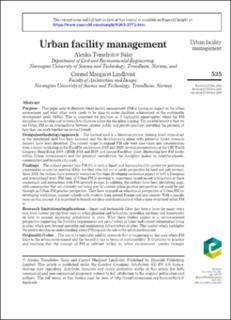| dc.description.abstract | This paper aims to illustrate where facility management (FM) is having an impact on the urban environment and what other work needs to be done to easier facilitate achievement of the sustainable development goals (SDGs). This is important for practices as it highlights opportunities where the FM discipline can develop and to research to illustrate where the discipline is going. The societal benefit is that we see Urban FM as an intermediator between citizens, public and private practices providing the platform of how they can work together for mutual benefit. The method used is a literature review, looking latest state-of-art in the mentioned field has been assessed and the developments along with potential future research focuses, have been identified. The current scope to expand FM role were also taken into consideration from a recent workshop at the EuroFM conferences 2019 and 2020, several presentations at the CIB World Congress Hong Kong 2019, CIRRE 2018 and 2019, and special Facilities’ issue, illustrating how FM works within Urban environments and the potential contribution the discipline makes on neighbourhoods, communities and broader city-scale. The authors present how FM fits in with a Smart and Sustainable City context by positioning communities as core for meeting SDGs, but they often fall out of needs perspective for hard and soft services. Since 2018, the authors have intensely worked on this topic developing conference papers at both a European and international level. The topic of Urban FM is growing in importance based on out interactions at these conferences and interactions with FM network groups. In addition, the authors have been identifying gaps, with communities that are currently not being met by current urban practice perspectives but could be met through an Urban FM practice perspective. They have engaged an educational perspective of Urban FM by developing workshops, summer schools with students from around Europe and new courses. With a specific focus on this concept, it is important to branch out ideas and disseminate of what a more structured urban FM is. Smart and Sustainable Cities has been a focus for many years now from various perspectives such as urban planning and technology providing solutions and frameworks on how to manage increasing populations in cities. What these studies neglect is a service-oriented perspective supporting the livability requirements and social values of future and current communities living in cities which goes beyond operating and maintaining infrastructure of cities. This neglect which highlights the need to develop an understanding where FM expands its role in the urban environment. The aim is to highlight solidify research that is happening in this area where FM links to the urban environment and the benefit it has in terms of sustainability. It illustrates to practice and teaching that the concept of FM is relevant within an urban environment, creates stronger connections within and between citizens and cities and illustrate how Urban FM is necessary in facilitating community facilities. Keywords: Sustainable development, Communities, Facilities management, Urban areas, Well-being, Smart cities, Urban FM, Sustainability, Health and well-being, Urban development, Community, PPPP | en_US |

